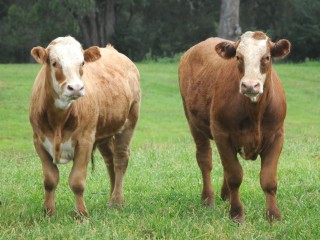 Cattle Council of Australia says it is on track to launch its Pasture-fed Cattle Assurance program in early 2012, going some way towards offsetting risks associated with brand claims like those currently being experienced in the chicken industry.
Cattle Council of Australia says it is on track to launch its Pasture-fed Cattle Assurance program in early 2012, going some way towards offsetting risks associated with brand claims like those currently being experienced in the chicken industry.
The Australian Competition and Consumer Commission last week launched Federal Court action against ‘free-to roam’ claims in chicken meat production, pursuing three large suppliers to Steggles and the chicken industry’s peak body (see separate story “Warning for beef in ACCC's 'free-to-roam' chicken challenge”).
CCA deputy director Jed Matz agreed with CAAB head Phil Morley’s assessment over the potential risk to the beef industry over the absence of minimum standards on product descriptions.
“Our concerns are not so much directed towards the prospect of ACCC action, but more to simply providing clarity to consumers when they make a beef purchase, in what it means when it says free-range, natural or pasture-fed,” he said.
“The last thing we want is for such terms to be compromised in some way. Consumers can then lose confidence in what can be very strong brand attributes to improve beef sales,” Mr Matz said.
The development of CCA’s Pasture-fed Cattle Assurance System has been a protracted exercise, by any standards. It was first discussed back in 2008.
Almost a year ago, CCA issued a statement saying it was “at the tail end” of finalising the standards that would underpin the marketing of Australian pasture-fed beef.
The current model under the proposal is two-tiered, encompassing elements for a ‘pasture finished’ and ‘life-time pasture-fed’ Standard. Both will require cattle to have continuous access to pasture, be MSA graded, have lifetime traceability and not be confined for the purposes of intensive feeding.
CCA president Greg Brown said earlier that substantiating pasture-fed beef in domestic and international beef markets through an assurance system meant beef producers right across Australia could capitalise on niche marketing opportunities through underpinning claims associated with their cattle production methods.
The Pasture-fed Cattle Assurance System had been designed to meet both the US ‘grass-fed’ beef and ‘natural’ standards and be eligible for the US Department of Agriculture verification process for both labels. By any standard, the USDA interpretation of “Natural’ could be considered extremely liberal, however.
CCA’s interpretation includes “not confined for the purposes of intensive feeding”, which applies to how animals are raised for both pasture-fed and free-range.
Responding to suggestions that CCA had ‘backed the wrong horse’ in its standards focus on ‘pasture-fed’, rather than ‘natural’, Mr Matz said there were distinct reasons for the direction taken.
“We originally intended to develop a ‘natural’ standard, but in the process of going through negotiations with industry, it was difficult to get support from across the entire spectrum of stakeholders over what the term, ‘natural’ really meant.”
It was easier to find consensus on ‘pasture-fed’, he said.
Despite this, CCA six months ago started working with the Australian Meat Industry Language and Standards Committee, through AusMeat to develop standards around ‘natural’ marketing terms.
Part of this includes scrutiny of approaches in other industries, like pork, which already has ‘free-range’ standards in place, in that case using an RSPCA definition. On its website, Australian Pork Ltd defines free-range as “pigs are kept outdoors with shelter from the elements provided, furnished with bedding. Free-range pork production consists of outdoor paddocks which include rooting and wallowing areas, and kennels.” Separate requirement are listed for breeding and growing pigs.
 Mr Matz agreed that the somewhat elaborate descriptors for free-range pork production could be driven by the wider distinctions between conventional pork production and free-range, than those applying to beef.
Mr Matz agreed that the somewhat elaborate descriptors for free-range pork production could be driven by the wider distinctions between conventional pork production and free-range, than those applying to beef.
One of the underlying concerns was that if the beef industry went down the path of defining ‘natural’ as simply meaning animals raised on grass, it would infer that all other production systems were in some way ‘unnatural.’
“That’s part of the reason why it has taken so long to progress the pasture-fed standards to a point where they are nearing commercial launch,” he said.
“There has been a lot of negotiating among stakeholders over what the standard are, so that we don’t step on people’s brands, and that the grainfed and grain-assisted production systems are not compromised in some way by the definitions used.”
“There were then stakeholders within the industry that we had to convince that it was in fact a good idea, and represented a market opportunity rather than some type of hurdle.”
Has the horse already bolted?
Mr Matz conceded that some criticism had been levelled at the standards project in now being ‘almost too late,’ because there was already a proliferation of brands making ‘natural’ and ‘grassfed’ claims across Australia.
“I can understand where some people are coming from when they ask whether the industry still needs a standard, given there is now a range of brands already operating commercially in that space,” he said. “However that does not dilute the need to draw a line in the form of a standard, under which a product should not be called natural or grassfed.”
Mr Matz said the US was seen as the market with the greatest potential to benefit from new industry standards.
“The other driver is that the feedback we have had from processors and exporters, as well as domestically, is that they believe they can pay a premium for a product carrying multiple attributes (grassfed, no HGP or antibiotic, MSA-graded, no confined feeding). However if it is just grassfed and nothing else, they would struggle to see enough value in it to pay a premium for eligible cattle.”
Trial underway
MLA has now been given approval by CCA to undertake a trial under the standards, managed by consultant, Peter Schuster.
A regional trial will occur through a Queensland processor, allowing any kinks to be ironed-out. The main focus will be to make sure the system is auditable, that it is not too costly for producers to carry out, and that it can be delivered to the processor in a manner that makes it commercially viable.
Following that, all going well, a full commercial launch should occur early next year.
Logos and imaging are being developed, but it is not intended that they necessarily appear on a piece of beef being retailed to the public, or on a restaurant menu. Instead they will underpin commercial brands, in the same way that MSA underpins quality and consistency on beef brands.
Broader label claim issues emerging
Aside from ‘raising’ claims like grassfed, Mr Matz said the bigger issue likely to emerge was labelling of beef products in general.
“Currently, the ACCC is the only instrument forcing users to comply with label claims. What does Five-Star or Four-Star mince, low fat, or HGP-free really mean?” he said.
“Do we have sufficient labelling laws to verify any brand claim – whether it be raising claims or product quality claims?”
“Currently we do not, but while the Torbay Bill in NSW Parliament was more about labelling of quality of meat, there could be some merit in looking at the Torbay legislation – not the content itself but the way it is put together – and considering whether there is a similar process that could be adopted nationally,” Mr Matz said.
